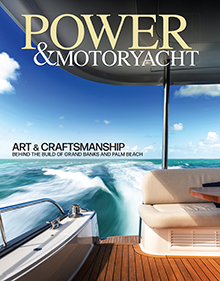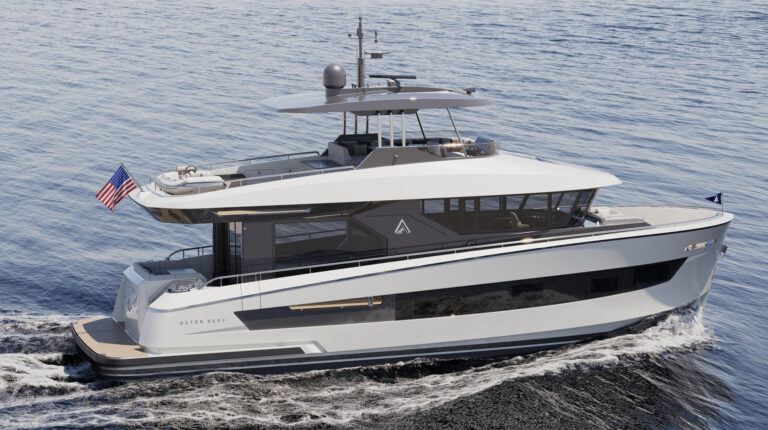
About twelve years ago, I was walking down a dock at the tail end of a product-demo event showcasing an array of boats with joy-stick-controlled stern-drive propulsion packages. Because the event had involved a rowdy bunch of marine journalists over a long, three-day period, the sales reps and engineers on the scene had grown a little weary. It was late in the afternoon on the last day, the Florida sun was beating down, and things had become quite informal and just a little loose.
“Hey, Gary,” I said, by way of striking up a conversation with an engineer I’d known for years. He was leaning against a piling. “This joystick thing you guys got goin’ here is good. Real good.”
Gary nodded. “But lemme ask you something,” I went on. “Do you think we’ll ever see a boat that’ll dock itself? I mean, a self-docking boat seems like a logical extension of joysticks. Just add GPS, or lasers, or something.”
Gary looked left. Then right. Then he looked me straight in the eye with a smile. “We’ve already got one,” he said. “With sensors and transmitters mounted both on board and around the slip—a computer gets everything to cooperate. It’s pretty cool.”
Of course, I immediately suggested Power & Motoryacht do a story about the boat. Where was she? Could we actually test her? Or ride along while she tested herself? Whatever!
“Nope,” he replied. “The legal beagles are nervous about liability. In fact, forget I even mentioned it—we don’t want publicity.”
More recently, at a boat show, an engineer working for another high-profile marine manufacturer virtually duplicated Gary’s revelation. Yes, he said, his company could create a self-docking boat, maybe even a self-driving boat, but such a thing would never see the light of day. “The liability is simply too great,” he concluded.
Right now, in spite of such liability concerns, driverless cars are on the move and driverless boats are probably not far behind. Indeed, a rather conventional-looking 29-foot driverless vessel developed by Carnegie-Mellon University’s Robotics Institute, a leader in the field of artificial intelligence (or AI) for decades, was featured just a few short months ago on the CBS news program 60 Minutes. If you caught the program, you saw correspondent Charlie Rose sitting in her cockpit cruising a Pittsburgh river sans skipper.
“The technology for boats is similar to, but less advanced than, what’s seen in autonomous cars today,” explains Robotics Institute’s principal systems scientist John Dolan. “To date, we haven’t yet embedded the algorithms necessary to allow a vessel to learn from its experiences and exhibit higher levels of autonomy. But can we develop something that both docks and operates itself? Sure. In fact, doing so would be somewhat easier than creating an automobile that can safely deal with the complexities of a busy city street.”
So okay! I’m not an old fogey, despite my age. And neither am I some kind of head-in-the-sand throwback. But hey, in light of tidbits like this one from AI guru Dolan, a big question arises in my mind, along with a couple of smaller ones. Yup, the autonomous “swarmboats” the U.S. Navy’s developing these days make sense—interdicting pirates and dealing with other dicey tasks is best done remotely, no question. And maybe autonomous cruise and cargo vessels that ply repetitious routes also make sense—exchanging the possibility of human error for AI control when monotony is a factor is probably a good idea as well.
But driverless recreational boats?
First off, let’s get real. Imagine a scenario where every time the wind is super-gusty or the current kicks up, you push a big red button labeled: “AUTOMATIC” and let a computer do your docking. Will you not eventually lose touch with the basic realities of your environment, and the ways you should react to them? And will you not be in deep doo-doo some day if AI fails you?
And then there’s the poetry of the whole thing. Undoubtedly, owning (and not operating) an autonomous vessel could be totally cool now and again, as well as convenient. But is it not true that, at least for some of us salty souls, actually running a boat, dealing with the characteristics of her hull form and propulsion system and how they interact with winds, currents, and other factors, constitutes much of the fun—indeed much of the beauty—of ownership?
Sorry, Mr. Roboto! You can forget about the ol’ Betty Jane II going full-automatic any time soon. Call me old-school, buddy. But I really do enjoy drivin’ my own boat.
Read more of the Exploits and Misadventures of Capt. Bill Pike here. ▶
This article originally appeared in the March 2017 issue of Power & Motoryacht magazine.










